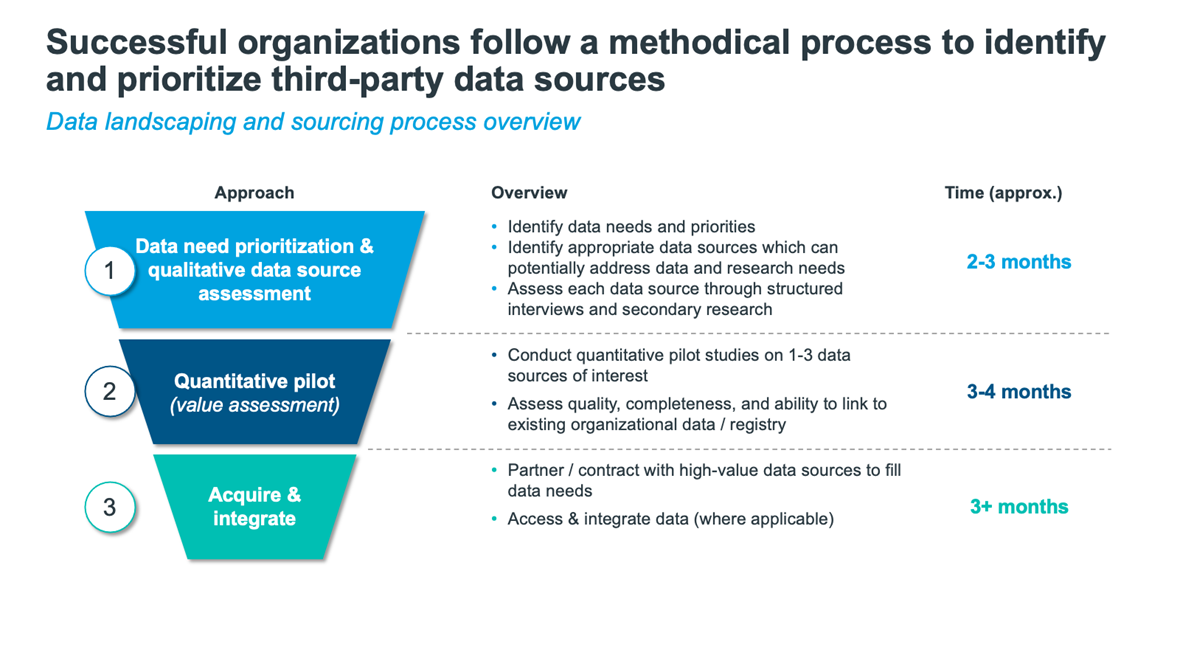















- Locations
- United States
- US Blogs
- Data Sourcing Blog Series Part 2: Identifying and evaluating new sources of real-world data
Finding and accessing these valuable data types for your populations of interest can be an overwhelming process
Despite the many benefits that can be realized by acquiring new types of data (see our recent blog post on the benefits of acquiring new types of real-world data for more information), many organizations fail to take advantage of these opportunities in part because of the overwhelming process of identifying and understanding the varied data landscapes.
While there are only a handful of consistently valuable types of data, the sources where you can access these data types frequently number in the hundreds. These dataset sources vary by ownership, size, duration, population, and access options, to name just a few. First making sense of all the available datasets and then identifying which are most appropriate for your organizational needs is a daunting task.
Health care organizations need a systematic way to identify, assess, and partner with relevant sources of data to support the needs of their organization and their members into the future.
What is data landscaping and sourcing?
Data landscaping and sourcing is a systematic process of identifying, assessing, and prioritizing external datasets best suited to address your unique needs, and then acquiring access to those datasets.
Whether you undertake this work alone or with a partner, following IQVIA’s proven, systematic process (Figure 3) will ensure that you can identify and evaluate the most appropriate datasets for your needs in a highly efficient and streamlined manner.

Figure 3: A methodical approach to identify and prioritize third-party data sources. This systematic approach allows for an effective and efficient prioritization of a wide landscape of potential data partners.
Overview of the three-step data landscaping and sourcing process:
- Prioritize data needs and qualitatively assess data sources
The first step in the data sourcing process is to understand how your organizational needs are supported by your existing data strategy, and where gaps remain.
After you have identified the highest-priority data gaps, organizations should identify external datasets that could fill those gaps, creating a comprehensive view of the existing data landscape, from which a small number can be prioritized for profiling through interviews with data source owners and secondary research.
These prioritized datasets are qualitatively assessed based both on their expected ability to meet your organizational needs, and important operational factors, such as cost, access models, expected quality, and control of data use and future data collection.
- Quantitatively evaluate datasets
Based on the qualitative assessment, successful organizations then choose just a few highly promising datasets for further quantitative evaluation through a pilot study. During the pilot, you will work directly with the data owners to obtain a comprehensive view of the presence, completeness, and quality of key variables required to address your organizational needs. Additionally, patient crossover between your patient population and the patients in the new dataset should be quantified to assess the potential to link the two data sources.
- Contract with the best data partners for your organization
Following the quantitative evaluation, you will be ready to select the most promising dataset(s) to formally partner with. Partnership can take many forms, from formally acquiring new patient-level data and linking it directly to your existing data for repeated use, to creating a federated data sharing model to allow you and your partner to work together on multiple research areas of common interest, to a single collaboration where you both retain your own data but agree on shared analysis for a one-off research project. Importantly, these partnerships can also evolve over time as you build trust in one another’s data and capabilities.
How can you get started?
For more information, such as organizations that have gone through this process, advice on identifying data sources relevant for your particular specialty area, or more details on data partnership and acquisition models, please contact Harvey Jenner or Jessica Preston at sustainability@iqvia.com.
ABOUT THE AUTHORS
Harvey Jenner, Associate Principal, IQVIA Healthcare Solutions
In his current role, Harvey leverages his scientific background and healthcare consulting experience to assist medical specialty societies and patient advocacy organizations to enhance their data-driven capabilities, provide sustainable registry value, develop research offerings, and navigate the complex data governance of multiple registries.
Harvey has been with IQVIA for 7 years, managing large, global projects for pharmaceutical companies, providers, and other healthcare organizations. Prior roles include data and evidence strategy and implementation roles in Real World Analytics Solutions. He has a BSc in Biology from Imperial College London. Harvey is based in San Francisco, California.
Jessica Preston, MPH, Associate Consultant
Jessica joined the IQVIA Healthcare Solutions team in 2021 to support patient advocacy organizations and medical specialty societies in developing registry and data strategies that support their core mission while also contributing to organizational sustainability. Previously, Jessica worked as a research analyst supporting health systems and their partners with topics such as medical group medication management, specialty pharmacy, and health system service allocation.
Jessica received a Master’s in Public Health and a BS in Biomedical Engineering from the University of Virginia. She is currently based near Washington, D.C.




